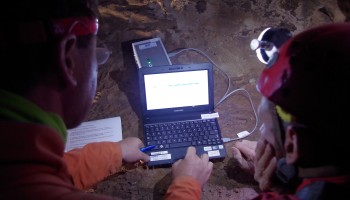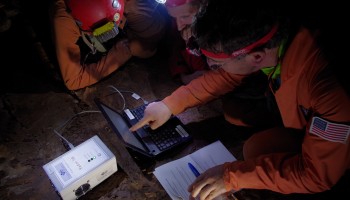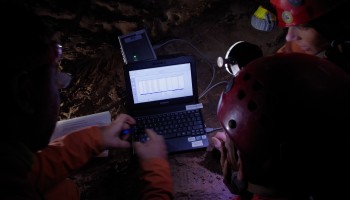Radon monitoring in caves
The objective of these measurements is to determine radon concentrations in the air. Radon is a radioactive noble gas, produced by the decay of the Uranium series isotopes. In closed environments radon is the most significant source of radiation exposure. Therefore, many countries have regulations fo radon concentrations in underground and indoor working spaces.
Radon in the air is measured by an electronic silicon detector (the “Radim 5B”). Radon diffuses into instruments detection chamber that is covered by a layer of material that captures radon decay products in the detection chamber. Radon activity is determined by measuring the α-activity of the decay products of radon, RaA and RaC, collected on the surface of a semiconductor detector by a high-intensity electric field.
Operational scenario
Air radon-concentration measurements are performed at the Witch Hat, at the Camp Site, and at the Water Tower. The Radim 5B measurement units are already in place.
- Download Radim 5B data (days 0-6)
- Use of Netbook and Radim cables
- Dose calculation on an excel spreadsheet (netbook)
During the evening of day 0, data are downloaded from the instrument at night in presence of the instructor at Witch Hat. On days 1 to 6, the Radim 5B unit is downloaded in the mornings at the Camp Site using Netbook and Radim cables. On day 3, the Radim 5B unit is read at the Water Tower by a Rugtab. If an advanced camp is established on day 4 in the Lakes Branch, the readings of a Radim 5B unit should be repeated on the morning of Day 5 by a Rugtab and dose calculations should be carried out on the instrument’s maximum concentration setting.
Things to keep in mind
Radim 5B measurement unit
The Radim 5B measurement unit is a delicate instrument when powered on. Please leave it on the ground, and don’t move it while connecting or disconnecting the USB Radim cable. Green lights indicate the instrument’s operation mode (see procedures). Check if the instrument is on and that it is connected to the netbook for data download.
The Rugtab is not able to download data properly, but is used to see measurements on video. Data download should be done with the netbook by preference. At advanced Camp data is only read without downloading to see radon concentrations and calculate doses .
The instrument can measure radon concentrations as low as 80 Bq/m3, and up to 50,000 Bq/m3. Typical cave values for radon concentration are of the thousands Bq/m3.
Radon behavior
Radon concentration in a cave’s atmosphere is influenced by a wide number of factors, such as Uranium concentration in the rock, porosity, air and water flow, atmospheric pressure, earthquakes and so on. In general, a seasonal fluctuation is observed with a maximum in summer and a minimum in winter, based on cave ventilation.
Prof. Jo De Waele, University of Bologna, CAVES science coordinator.
Dr.. Massimo Esposito, U-Series, radiation protection expert.
Dr. Laura Sanna, Institute for Biometeorology, Sassari, scientist responsible for the CAVES environmental science experiments.




Discussion: one comment
I found this article:
Radon Measurements in Underground Mines and Caves From Several European Countries
Romul Mircea Margineanu
dated in 2019, and in Fig 6 they show a completely atypical behavior for Radon determination in Castañar, Spain. Any comment about why this änomaly” occurs?